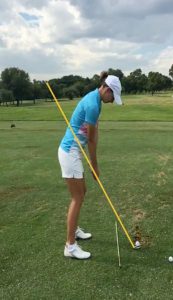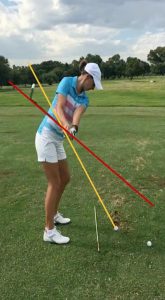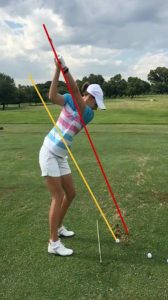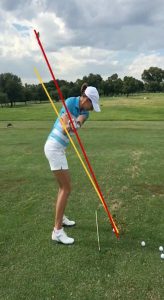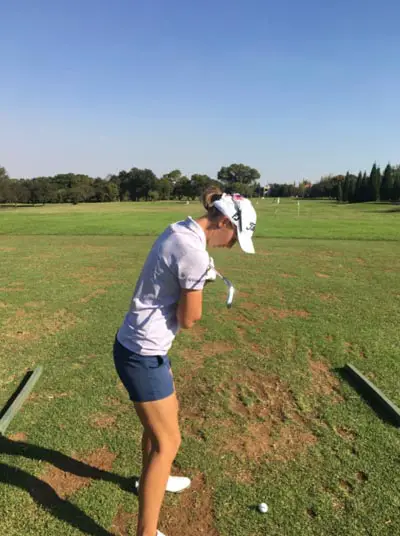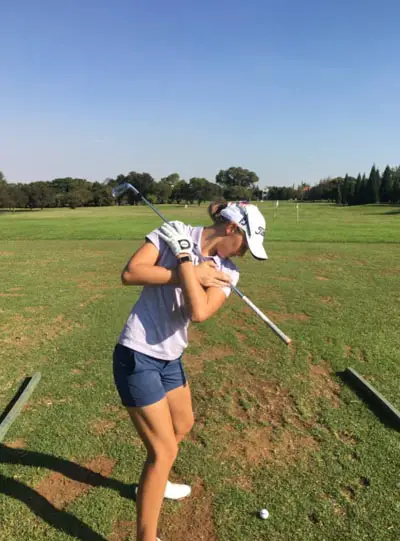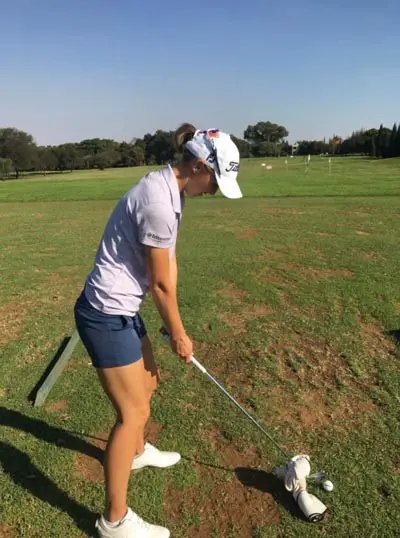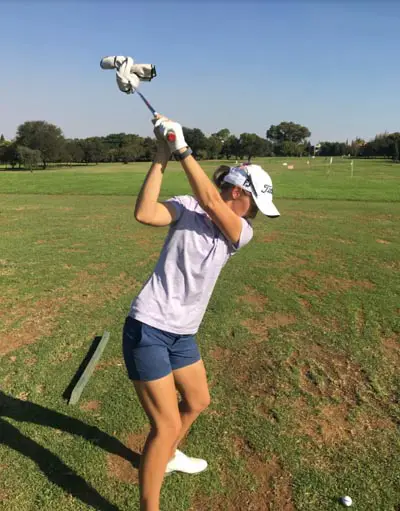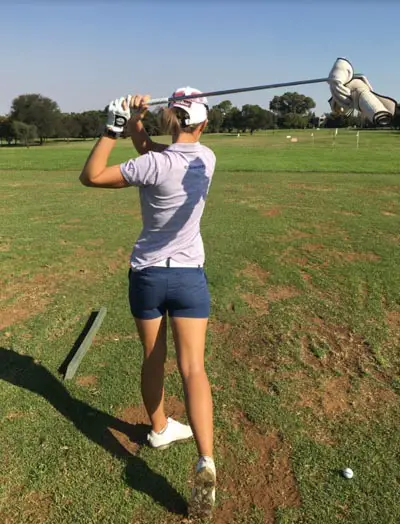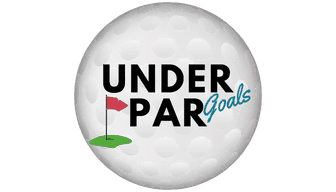One swing plane, two swing plane, which one is best, and how do I swing the club that way? Swing plane might be a foreign concept to some golfers but the majority of us have either read about swing plane or it has come up in a conversation with other golfers.
If your mind is filled with confusion around the topic then this article is for you. Below we are going to look at what swing plane is, what the different types are, and at which swing plane is best for you.
What is the golf swing plane?
The term swing plane was first introduced by one of the all-time golfing greats, Ben Hogan. In modern golf terms, swing plane is defined as the vertical angle between the ground and the circle that the clubhead travels on during the bottom portion of the swing arc. Back in the days of Hogan, players didn’t have access to anything close to the technology today. Modern golfers use video cameras, launch monitors and technical analysis of the golf swing. Until recently, this was a foreign concept to many golfers.
The modern-day definition of the swing plane is filled with technicalities. Instead of trying to make sense of all of these angles think about the swing plane like this. The swing plane is an imaginary flat surface that indicates the angle of both your backswing and follow-through. If this angle remains the same for your backswing and follow-through you have a one plane swing. If this angle differs then you have a two-plane swing.
One plane swing
The one plane swing can also be described as a traditional swing plane. A one plane swing refers to the action of taking the club back and through on the same angle to the ground hence the name one swing plane. Historically the one swing plane has been a favorite amongst coaches because it is technically very sound and relatively easy to repeat once you get the grasp of it.
If you are having a hard time imagining what a one plane swing looks like think about it this way. Imagine standing inside a giant hula hoop that is angled at roughly 45 degrees. If your both backswing and follow through follows the arch of the hula hoop, then you have a one plane swing.
One plane swing – hands stay on the plane (angle of the hula hoop) as illustrated by the yellow line.
Pros and cons of a one plane swing
The one plane swing is simple and easy to repeat, and allows for your body to work together as a unit. With the visual of a unit in mind, it is easy to see why this swing type produces consistency. The one plane swing, when executed correctly, should improve your accuracy. This is especially true with an iron or wedge in hand.
The one plane swing is a very compact motion. For some players, a one plane swing restricts their natural strength and ability. If consistency is what you are after then yes, the one plane swing is for you. If maximum distance and the ability to work the golf ball both ways is on your radar then a two-plane swing will offer more versatility.
Two plane swing
The two plane swing is seen as a more unconventional way of swinging the golf club. Using a two plane swing is becoming more and more common amongst professional players. The game as we know it is changing, and in the quest for faster swing speeds and extra distance, the two plane swing has become more and more popular as a result.
If you are having a hard time imagining what a two-plane swing looks like think about it this way. Imagine standing inside a giant hula hoop that is angled at roughly 45 degrees. If either your backswing or follow-through does not follow the arch of the hula hoop, then you have a two plane swing. Two plane swings are renowned for looking uncharacteristic and can easily be spotted with the naked eye.
Two plane swing – as illustrated by the red line the hands switches (moves away from the hula hoop) planes throughout the swing
Pros and cons of a two-plane swing
The implementation of a technically sound two plane swing requires dedication and practice. If you are willing to put in the practice though a two-plane swing can be very beneficial for your golf game.
Due to the physics behind the two plane swing, players can generate higher clubhead speeds. In return, this leads to added distance.
On the downside, however, the two plane swing isn’t for everyone. Tall strong players are built for a two plane swing, the opposite however is true for shorter golfers or for those that lack muscle power.
The two swing plane also requires exceptional control of your body to ensure that your body works in sync with the club. If all of the parts of a two plane swing don’t match up accuracy and consistency will be a massive issue.
How do the pros swing it?
By now you should have a better understanding of what a one plane and two plane swing are. To get a better understanding of these two swing plane types let’s take a closer look at how the pros swing it and at why either works for them.
Ben Hogan created the concept of the one and two plane swing. Hogan opted for the one plane swing and with the physics in mind, it is easy to understand why Hogan was one of the best ball strikers the game has ever seen. Vijay Singh is another tremendous ball striker that swings the club on one plane.
The one plane swing can be implemented in a variety of different ways. PGA Tour players such as Adam Scott, Rickie Fowler, and Zach Johnson all have one plane swings. Even with a quick glance at each of player, it’s obvious their swings look very different.
Jack Nicklaus has a two plane swing. Jack’s swing is described as unconventional by many, which is the case for the majority of players with two plane swings. Jim Furyk, Bubba Watson, and Matthew Wolff all have unique two-plane swings. Watson and Wolff in particular utilize the flexible parameters of the two-plane swing, especially off of the tee. Both of these players can hit the golf ball miles.
Ever since Bryson Dechambeau won the US Amateur in 2015, the golf world started to take notice. Dechambeau, one of the best amateur players in the world at the time, wasn’t your average golfer. Bryson, a physics major at SMU approached golf differently, and in the last 5 years has continued revolutionizing the game. One length irons, oversize grips, and an uncharacteristic one plane swing is just the beginning as to what makes Dechambeau unique. His results speak for themselves and his recent runaway victory of the 2020 US Open at Winged Foot further proves that there is more than one way to play this game.
When it comes to swing plane, Dechambeau opts for a one plane swing. Bryson didn’t choose to swing the club like this by accident. His choice is backed by physics and according to his rationale, the one plane swing is the easiest way to swing the golf club the same way with every single shot.
Let’s take a closer look at how Dechambeau swings the club on the same plane every time.
Rest the club in the palm and not the fingers
A one-plane swing requires a strong grip. By resting the club in the palm of your hand instead of in your fingers ensures a stronger more locked in grip. Bryson uses oversize grips on his clubs for this exact reason, a thicker grip makes it easier to grip the club in the palm of your hand.
Start the club before you start the swing
Use a trigger to start the club before starting the swing. Bryson’s trigger is to push his hands forward right before he starts his backswing, the use of this trigger ensures that his wrists and arms are working together on the backswing which is one of the keys to a one plane swing.
During the backswing, imagine an upright circle surrounding your body
We touched on this earlier and Bryson does it as well. Imagine swinging inside a circle or a hula hoop with the club following the same patch on both the backswing and the follow-through. This visualization can be applied to both your short game and your long game.
Maintain a flat hand at the top of the backswing
Bryson maintains a flat hand at the top of his backswing, what this means is that he doesn’t set the club with his wrists at the apex of his swing. Keeping your wrists locked at the top of your backswing ensures that the club doesn’t get rerouted on a different path on your downswing.
Rotate your body around a center point
Rotation is key when using a one plane swing. Rotation through your hips and shoulders is vital to ensure that the club stays on the same path, and any lateral movement will change the plane of your swing. Dechambeau works very hard on his flexibility and rotation power in the gym and he does it for exactly this reason.
Swing drills to perfect each plane
One-plane swing | The hula hoop drill
I’ve referred to a hula hoop on multiple occasions, and there is a good reason. When it comes to grasping the feel of a one plane swing the hula hoop analogy does explain it best. For this drill, you require a hula hoop and two alignment sticks. Place the stakes into the ground about the width of the hula hoop apart. Prop the hula hoop up between the stakes as illustrated by the graphics in the image below.
Once the hula hoop is in place, set up to a golf ball as you normally would and allow the arc of the hula hoop to guide your swing. Swing along the arc of the hula hoop as often as possible, hitting golf balls isn’t required, you can do this drill in your backyard. The more you do it, the faster you will get used to the feel of a one plane swing. When swinging along the arc of the hula hoop occasionally swing with your eyes closed. By closing your eyes your other senses will be heightened and will force you to feel the path of your hands instead of relying on your vision to guide your swing.
One-plane swing | Rotation drill
Rotation of the hips and shoulders is key for players with a one plane swing. A great rotation drill is to cross your arms and to grab onto your shoulders. Address the ball as you normally would and turn your shoulders until your left shoulder is pointing at the position of the golf ball. Do this drill as often as possible to get the feel of a good shoulder turn but also to increase your range of motion.
Two plane swing | Broom drill
The two plane swing requires exceptional rhythm and timing, and this is where it goes awry for many amateur golfers.
The broom drill is a great drill to improve your rhythm and timing which will ensure that you get the maximum benefit out of your two plane swing. You don’t necessarily have to do this drill with a broom. Simply take your towel and wrap it around the bottom of your clubhead. With the towel in place, take a few swings. The aim of the drill is to feel like you are sweeping the golf ball off of the grass with the towel. With a two plane swing you are likely to hit the ground behind the golf ball if your timing is off. This drill will ensure that doesn’t happen and that the clubhead can move through the hitting area optimally.
Final Thoughts
The one plane vs. two plane swing is an ongoing debate amongst golfers and teaching professionals. Regardless of which one you choose to go with, always remember to swing your swing. Not all of us can swing the club like Dustin Johnson or Rory McIlroy, at the end of the day you have to stick with what works best for you.
